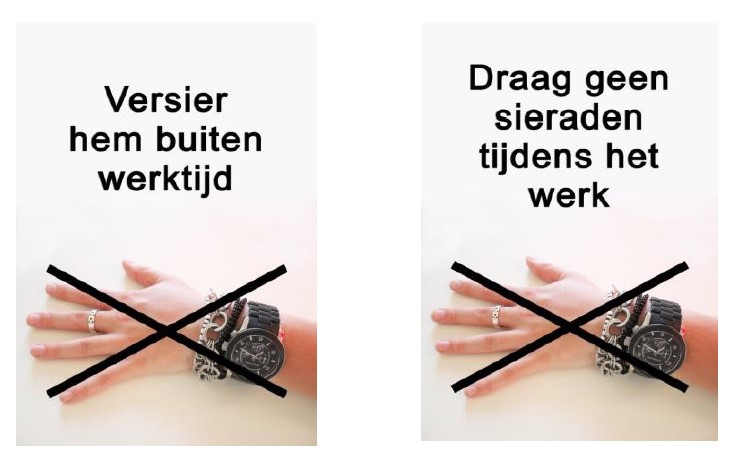While searching for more information on what Social Posters should look like in order to be effective, I came across a useful master thesis from Hilde Dorman (2015) titled “Effects of a pun versus an explicit message on behavioural change”.
Dorman begins by highlighting the complexity of understanding the effect of posters that do not serve a commercial purpose. She writes that in commercial advertising, simple messages (e.g. the stimulation of a purchase or branding) are communicated while in public communication more complex messages have to be send which serve the purpose of stimulating non-harmful behaviour in citizens (Dorman, 2015, p.10).
Dorman (2015) takes the problem of nurses in care homes wearing jewellery to work as an example and investigates in how far a poster can inspire the nurses to change their behaviour for the better (not wearing jewellery). As a basis of her research functions the distinction between planned and automatic behaviour: “According to Pol et al. (2013) an estimated 95% of our behaviour is automatic behaviour. Automatic behaviour can be defined as behaviour we do not consciously think about” (Dorman, 2015, p.14). Dorman tries to influence the latter via a prompt, that is posters that are hung in the facilities of the nurses’ workspaces.
While doing so, she pays special attention to the element of creativity in the message on the poster, that is if the message is novel, meaningful and connects the audience (Dorman, 2015, p.16). Reviewing literature, Dorman writes that “posters with a pun increase the attitude, attention and recall towards the poster (Toncar et al., 2001; McQuarrie & Mick, 1999; McGuire, 2000) [but] they are more difficult to understand, and it is less likely that they lead to behavioural change than a poster with an explicit message (Van Mulken et al., 2003; Berendsen, 2012)”.
To test this, Dorman (2015) displayed two posters and measured how many people were wearing jewellery before and afterwards in addition to conducting interviews with the recipients. The two posters were identical; however one contained a pun (“versier hem buiten werktijd” = trnsl. to “decorate it outside working hours “) and the other an explicit message (“draag geen sieraden tijdens werk” = transl. to “Do not wear jewelry while working”):

Dorman (2015, p.40) comes to the conclusion that a behavioural change did occur after the posters were hung and that “respondents had a more positive attitude towards the poster with the pun and the poster with the pun caught also more attention than the poster with the explicit message”. However, surprisingly, the poster with the pun did not lead to more behavioural change and no better recall and perceived comprehension. She writes that “[t]hose outcomes indicate that the exposition of the posters have served as a prompt, which triggered unconscious processing and finally led to automatic behavioural change” (Dorman, 2015, S.40).
I found this study incredibly fascinating. Creativity does not seem to play such an important role in the poster design. However, Dorman also notes that her study stands in contrast to a similar experiment by Femke Berendsen (2012, as cited in Dorman, 2015) where the poster with the creative message had a higher effect on respondents. It seems like there is a lot of room for further research in this field. And this of course applies only to a small part of all the Social Posters, it still does not explain what effect e.g. a protest poster can have on onlookers.
References:
- Dorman, H. (2015). Effects of a pun versus an explicit message on behavioural change [MA thesis]. University of Twente.